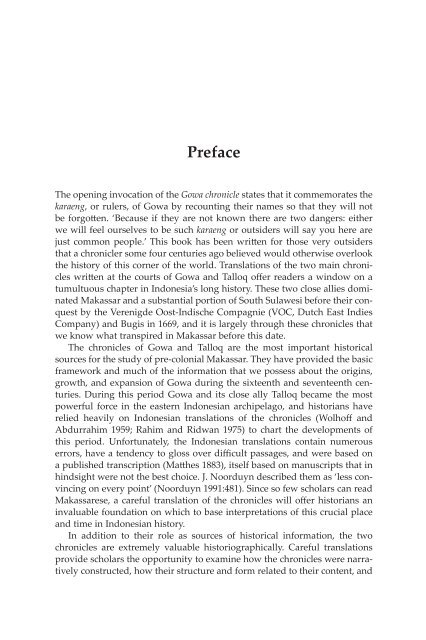A CHAIN OF KINGS - Books and Journals
A CHAIN OF KINGS - Books and Journals
A CHAIN OF KINGS - Books and Journals
Create successful ePaper yourself
Turn your PDF publications into a flip-book with our unique Google optimized e-Paper software.
Preface<br />
The opening invocation of the Gowa chronicle states that it commemorates the<br />
karaeng, or rulers, of Gowa by recounting their names so that they will not<br />
be forgotten. ‘Because if they are not known there are two dangers: either<br />
we will feel ourselves to be such karaeng or outsiders will say you here are<br />
just common people.’ This book has been written for those very outsiders<br />
that a chronicler some four centuries ago believed would otherwise overlook<br />
the history of this corner of the world. Translations of the two main chronicles<br />
written at the courts of Gowa <strong>and</strong> Talloq offer readers a window on a<br />
tumultuous chapter in Indonesia’s long history. These two close allies dominated<br />
Makassar <strong>and</strong> a substantial portion of South Sulawesi before their conquest<br />
by the Verenigde Oost-Indische Compagnie (VOC, Dutch East Indies<br />
Company) <strong>and</strong> Bugis in 1669, <strong>and</strong> it is largely through these chronicles that<br />
we know what transpired in Makassar before this date.<br />
The chronicles of Gowa <strong>and</strong> Talloq are the most important historical<br />
sources for the study of pre-colonial Makassar. They have provided the basic<br />
framework <strong>and</strong> much of the information that we possess about the origins,<br />
growth, <strong>and</strong> expansion of Gowa during the sixteenth <strong>and</strong> seventeenth centuries.<br />
During this period Gowa <strong>and</strong> its close ally Talloq became the most<br />
powerful force in the eastern Indonesian archipelago, <strong>and</strong> historians have<br />
relied heavily on Indonesian translations of the chronicles (Wolhoff <strong>and</strong><br />
Abdurrahim 1959; Rahim <strong>and</strong> Ridwan 1975) to chart the developments of<br />
this period. Unfortunately, the Indonesian translations contain numerous<br />
errors, have a tendency to gloss over difficult passages, <strong>and</strong> were based on<br />
a published transcription (Matthes 1883), itself based on manuscripts that in<br />
hindsight were not the best choice. J. Noorduyn described them as ‘less convincing<br />
on every point’ (Noorduyn 1991:481). Since so few scholars can read<br />
Makassarese, a careful translation of the chronicles will offer historians an<br />
invaluable foundation on which to base interpretations of this crucial place<br />
<strong>and</strong> time in Indonesian history.<br />
In addition to their role as sources of historical information, the two<br />
chronicles are extremely valuable historiographically. Careful translations<br />
provide scholars the opportunity to examine how the chronicles were narratively<br />
constructed, how their structure <strong>and</strong> form related to their content, <strong>and</strong>









![Am HaSefer [Volk des Buches] - Books and Journals](https://img.yumpu.com/20648352/1/174x260/am-hasefer-volk-des-buches-books-and-journals.jpg?quality=85)







